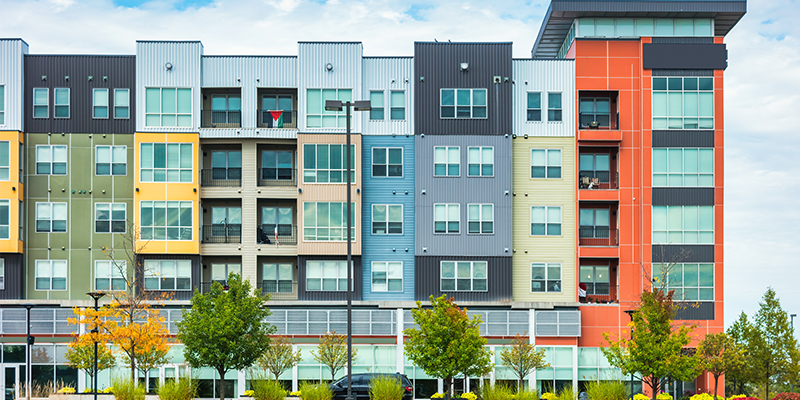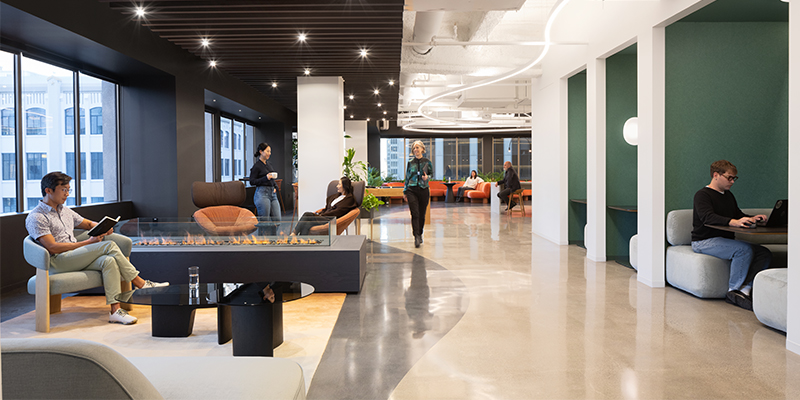By Sanziana Bona
As the modern workplace continues to evolve, so does the coworking industry, adapting to shifting employee preferences, real estate trends and the ongoing hybrid work revolution. Recent national data from a Yardi Kube analysis reveals a compelling trend: suburban coworking spaces are growing faster than their urban counterparts, signaling a potential long-term transformation in how and where Americans choose to work.
The Rise of Suburban Coworking: A 58% Development Surge
In a striking shift, suburban coworking spaces have experienced dramatic expansion over the past two years. Between 2023 and 2024, the total suburban shared workspace square footage grew from 55.5 million to 68.2 million square feet, and by January 2025, it had already surpassed 87.6 million square feet. That marks a remarkable 58% increase in suburban coworking space in just two years.
By contrast, urban coworking growth has remained relatively flat. From 60.7 million square feet in 2023, urban coworking space increased to only 62.2 million in 2024 and reached just 63.2 million in 2025 — a modest 4% uptick.
What’s fueling this suburban surge? Several key factors: the rise of hybrid and remote work policies, rising urban commercial real estate costs, and the appeal of working closer to home. These forces have aligned to drive a preference for coworking environments that offer flexibility, affordability and accessibility in suburban settings.
Market Leaders in Suburban Coworking Growth
Among U.S. metros, Los Angeles leads the way in suburban coworking space volume, boasting over 7 million square feet in 2025, a slight decline from 7.4 million in 2023. Greater metropolitan areas surrounding Dallas and Chicago follow closely, both experiencing strong growth. The greater Dallas market saw a leap from 4.5 million square feet in 2023 to 6.3 million in 2025, while areas surrounding Chicago nearly doubled their suburban coworking footprint in the same period, from just over 3 million square feet in 2023 to nearly 6 million in 2025.
Perhaps the most notable jump comes from Jacksonville, Florida. In 2023, it ranked 40th in suburban coworking space with just over 270,000 square feet. By 2025, it had climbed to 27th place with more than 1 million square feet – a staggering leap driven by both demand and strategic development.
Urban Coworking Stays Strong but Slows
Urban coworking spaces aren’t disappearing, they’re just growing at a slower rate. New York City continues to lead the nation in urban coworking volume, with 14.8 million square feet in 2025. However, that’s down from 16.7 million in 2023, reflecting the broader trend toward decentralization.
Los Angeles maintains second place with 5.7 million square feet of urban coworking space, slightly down from prior years. Chicago, Washington, D.C., and San Francisco complete the top five, though Chicago saw a significant drop from 4.2 million to 3.8 million square feet in its urban coworking footprint.
Interestingly, Riverside, California, made the largest leap in urban coworking rankings, jumping 28 positions between 2023 and 2025. It added nearly 1 million square feet of urban shared space, signaling emerging demand in what were once considered secondary markets.
Suburban Share of Coworking Markets
Data from 2025 shows that some cities are heavily suburban in their coworking space distribution. Indianapolis and Virginia Beach, Virginia top the list, with 83% of their shared office space located in suburban areas. Close behind are Charlotte, North Carolina; Phoenix; and Jacksonville, all with more than 80% of their coworking supply outside traditional city centers.
This stands in stark contrast to New York City, where 75% of coworking space remains urban. NYC’s unique layout and extensive public transit make urban coworking a natural fit. Moreover, its dense professional networks and expensive real estate make shared offices a logical and necessary option for freelancers, startups and small businesses.
Other cities where urban coworking still holds the edge include San Francisco, Seattle, Salt Lake City, Boston and Providence, Rhode Island – but in most cases, the margins are narrow, often between 50% and 60%.
Dramatic Differences in Growth Rates
Several cities showcase just how dramatic suburban expansion has become. Take Fresno, California: between 2023 and 2025, suburban coworking space grew by 756%, while urban space increased by just 750 square feet. While Fresno’s total shared space remains modest at around 545,000 square feet, the overwhelming majority of that growth came from suburban areas.
Virginia Beach, too, saw a 224% increase in suburban coworking square footage, growing from 308,374 to over 1 million square feet in just two years. Meanwhile, its urban coworking space declined by 14%, falling to just over 210,000 square feet.
Jacksonville’s story is similar, where suburban coworking space grew by over 730,000 square feet – a 269% increase – while urban coworking space rose just 67%. In Phoenix, suburban coworking now accounts for four times the space found downtown, while Pittsburgh’s suburban spaces are rapidly catching up, despite urban coworking still holding a slight lead.
What It Means for the Future of Coworking
These patterns point to a significant shift in the coworking industry. Once dominated by sleek downtown hubs, the sector is moving toward a decentralized model that embraces suburban growth. Several reasons account for this transformation:
Hybrid Work Culture: With more professionals working remotely part-time, there’s a strong desire for local coworking options that don’t require a commute downtown.
Affordability: Suburban locations often offer lower rent, making them more attractive to operators and tenants alike.
Lifestyle Preferences: Workers are increasingly prioritizing work-life balance, and suburban coworking spaces reduce travel time and improve accessibility.
Business Strategy: Companies are decentralizing to attract talent, cut costs and provide flexibility for dispersed teams.
A Redefined Work Landscape
The rapid expansion of suburban coworking spaces reflects a broader reimagining of where and how we work. While urban coworking hubs like New York and San Francisco continue to play a vital role, the tide is clearly turning toward suburban flexibility and convenience.
As coworking space providers follow this locational shift in demand, we can expect a more balanced distribution of shared office spaces across the country. For businesses, this means new opportunities to tap into local talent pools. For workers, it promises more convenient, cost-effective and comfortable work environments. And for the coworking industry, it marks the beginning of a new era – one that extends far beyond the city skyline.
*Yardi experts assessed location type based on a combination of data points, including building density, proximity to business districts or the downtown core, accessibility via public or private transportation and price per square foot relative to the broader metro market.








